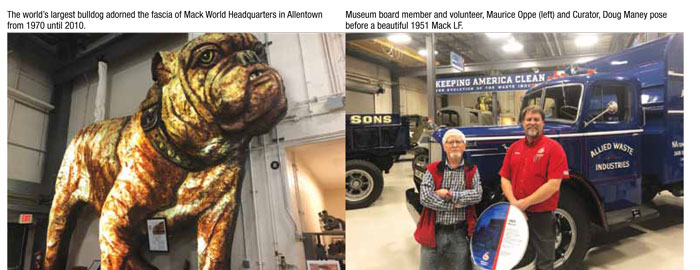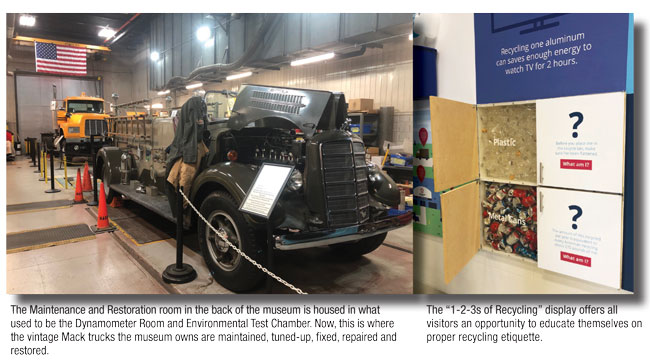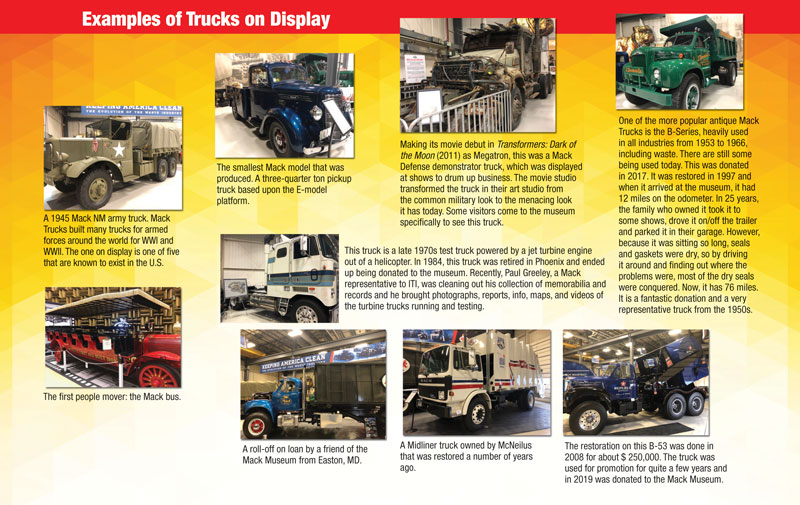Hosting both customers and visitors from all over the world, and averaging more than 10,000 guests per year, the Mack Trucks Historical Museum in Allentown, PA offers a valuable look into the world of the company and some of the first commercial trucks built in America. The Mack Museum began as a non-profit corporation, separate from Mack Trucks, and is dedicated to commemorating Mack history through service and parts information, engineering drawings, photos, memorabilia and a collection of vintage Mack truck models.
Originally opening its doors in 1982 in what was a former municipal garage on Main Street in Macungie, PA, the Mack Trucks Historical Museum, now located in the Mack Customer Center in Allentown, PA, has a colorful and interesting history. The Museum has showcased a variety of truck models from all industries throughout the years, featuring a variety of themes from “Pride of the Highway,” “Building America” and “The Versatile B-Series” to the current display, “Keeping America Clean: The Evolution of the Waste Industry.”

With a plan and budget to initially start a museum in 1972 with a handful of vehicles and enough information to open a small facility, the Mack historical display was to be included in the American Industrial Truck Museum. However, after failing to get traction from industry supporters, Mack opened the Mack Trucks Historical Museum in Macungie, PA. In order to promote the opening, Mack suggested that the Antique Truck Club of America relocate their show to Macungie Memorial Park. Mack donated the funds to rent the location for the show. In 1982, the show was moved to the park, and the museum opened, starting a great relationship between the two groups that still exists today.
In 1984, the museum was incorporated, and it stayed in Macungie until 1995 when it was moved into a part of Mack’s Lehigh Valley Operations factory and then moved again in 1997 to a location near the Lehigh Valley International Airport in Allentown. “At that location, they had a little bit bigger space and they could get almost every truck that they owned under one roof. The staff had increased in size, visitation was increasing slightly and so were the requests for information,” says Doug Maney, the current Curator of the Mack Museum. When the museum was located in Macungie, there was one person on staff—the original curator, Colin Chisolm, and 12 vehicles on display. In 2009, when the Engineering, Development and Test Center vacated from its building adjacent to the Queen City Airport, the decision was made to use the building for a customer center, product showroom, while also relocating the museum there. The current Mack Customer Center opened in 2010 and hosts both customers and visitors from all over the world, with the museum averaging more than 10,000 guests per year, with 12,000 visiting in 2018 and similar numbers for 2019.
Entering the Museum
In the museum’s reception area, a Dealer Membership Wall recognizing Mack dealers who support the museum, is the focal point. These dealers have partnered with the museum at different levels (platinum, gold, silver) to help the museum in its endeavors. In addition, a Top Dog Donor Wall features individuals and companies who also support the museum monetarily or with other services. Maney points out that these walls show the dedication of individuals and dealers who appreciate what the museum does to preserve Mack history. “This is our opportunity to educate visitors on what they see in the museum. In addition to customers and truck enthusiasts, we get school tours and group tours covering all age ranges. These group tours are typically led by a museum ambassador. Our self-guided audio tours are available in English, Spanish and French. The tour starts with the Mack history timeline and then a trip to the main gallery.”

The main gallery is a former test area. Maney explains that destructive testing was performed in this area when it was the Engineering, Development and Test Center. “They would do cab crush tests, bounce tests, door slam tests, torsional stress, road simulators, etc. We not only try to keep the gallery looking as industrial appearing as possible, but we also make it into a fitting environment for some beautiful trucks.” Display changes are made quite often. Currently, the museum’s main exhibition, “Keeping America Clean: The Evolution of Waste Collection”, is dedicated to the waste industry. This showcase was driven by the incredible history Mack has in the waste collection industry and the donation of Republic Services’ three vehicles—a Mack AK, a Mack LF and a Mack B-53 model. “They had them in their storage facility and they hadn’t recently used them for promotion, so Don Slager, CEO of Republic Services, decided that in lieu of having them just sit, it would be more beneficial to have them displayed in a place where they could be enjoyed.” explains Maney. “They donated the trucks at the beginning of 2019, and we opened the waste industry display on June 13, 2019. The Keeping America Clean display covers the evolution of the equipment used as well as the influence of Wayne Huizenga and his vision for the companies that he has created. There is an additional truck currently undergoing restoration that will be included in the Republic donation—a 1970 Mack DM-600.”
The earliest truck the museum has on display is a 1923 AB—an open top dump truck. “In the earliest days of refuse collection, ash from furnaces, fireplaces and boilers was collected. Household, institutional and industrial waste was burned to produce something they needed, such as steam or simply heat for their facility, and the result was ash. In the early design of trucks, the radiator was positioned in front of the vehicle, which made it easily susceptible to damage. Because of the increasing popularity of trucks, competition was created between the truckers and the operators of teams of horses, who did not like that trucks were coming in and taking their work. It did not take long for the wagon operators to determine that if they could position themselves in front of the truck, they could make their horses buck, impacting the radiator with the corner of the wagon, putting the truck out of service for a while. As a result, when Mack designed the AC, the radiator was moved to the rear of the engine so it could not be so easily damaged. It was unique and created a new look for the truck that was used until 1939 when those models were discontinued,” says Maney.
The museum rotates vehicles on display several times a year, and loaned trucks move in and out as they are available. Maney says he likes to change up the trucks because sometimes customers and visitors will come in two or three times per year and he wants them to see something different every time.
In addition to the three Republic trucks on display, the company also created an education station for visitors, which covers the 1-2-3s of recycling. It educates the audience on what is recyclable and non-recyclable. It also explains how things are collected and recycled through door flaps, videos and other fun facts. Work boot footprints on the floor let visitors follow in the footsteps of the people who work in the industry to make our world a cleaner place.
Around the Museum
In addition to the “Keep America Clean” display theme at the front of the gallery, the Mack Museum also showcases other trucks and items of interest throughout the facility, including a 1945 Mack NM army truck. Mack Trucks built many trucks for armed forces around the world for WWI and WWII; however, most of them did not come back to the U.S., so many of them are still in service in Europe and overseas. The one on display is one of five that are known to exist in the U.S. The truck had been at a military range, destined to be used for target practice, with the artillery range in control of its fate. The museum learned in 2009 about the truck located at the Fort Indiantown Gap. In 2011, museum staff members and volunteers were finally able to see it and evaluate its condition. A year later, the truck was released to the museum where the six-year restoration began. The restoration was done by volunteers with donated funds and materials when possible. Maney explains one unusual path they had to take to get one of the critical parts, “When we started taking it apart, we found that in the oil filter system, the canister was empty, and the necessary guts were not in it. Here in the States, these parts are non-existent. We knew what it was supposed to look like, so we had to reach out to fans of Mack Trucks around the world. The Dutch Mack Fan Club, based in the Netherlands, came through for us. They still run WWII trucks in different industries over there, so one of the members brought the guts in a suitcase when they came to visit the 2014 Mid-America Trucking Show.”
Since restoration, the museum has taken it to several military events, and it has been very well-received. “We took it to a WWII weekend in Reading, PA, the second largest WWII re-enactment in the world, held at the Mid-Atlantic Air Museum. When I had the truck in line for the parade, an older gentleman approached and asked, ‘Is it a Mack?’ I said, ‘Yes, sir, it is,’ and he says, ‘I haven’t seen one since I was in France in WWII.’ I hopped out of the seat and shook his hand and said, ‘You are welcome to get a ride.’ That is the connection that these trucks have with people. These trucks mean something, whether is it from a war or your family’s livelihood,” stresses Maney.

Between framed photos, toy trucks, etc. and the world’s largest bulldog that used to sit on top of world headquarters, there are more than 5,000 pieces on display in the museum, including vintage signs, display cases, and various mechanic tools, large and small. There is a large display of model trucks built by Jim Etter, a mechanic at a Mack dealer in Chambersburg, PA in the 1970s. Maney explains that at the time he built them, there were no model kits other than the basic models of Mack trucks, so he had to custom-build the molds to create the resin castings to use. “Essentially, he created this industry of model trucks to the point where there are different people doing it today. His business was American Truck Models; he would build his models for Mack executives, Mack employees who were retiring, special customers, etc.” A few years ago, a friend of Maney’s acquired all of Etter’s old molds and started the business again, building kits and truck models for customers.
The Maintenance and Restoration room in the back of the museum is housed in what used to be the Dynamometer Room and Environmental Test Chamber. Here, Mack technicians would test the trucks in various environmental conditions, including extreme cold, heat, rain and snow with headwinds replicated at 60 mph at full speed. They would also conduct engine braking tests, design functionality tests or test to see if the air-conditioning unit would keep the cab cool in desert conditions. Now, this is where the vintage Mack trucks the museum owns are maintained, tuned-up, fixed, repaired and restored. It is the home base for volunteers who come in Tuesdays and one Saturday a month to work on the trucks. Maney comments that one volunteer drives an hour and a half from West Chester, PA. The 25 or so volunteers log their hours; last year, there were more than 2,500 hours donated, with one volunteer logging 1,000 hours.
Giving Back
Held every two years, the Mack Museum’s Trucktoberfest began in 2012 as an appreciation event for volunteers and the antique truck community: the Antique Truck Club of America, the American Truck Historical Society and the Society for the Preservation and Appreciation of Antique Mobile Fire Apparatus of America. Trucktoberfest was created to thank the volunteers for contributing their time and helping the museum with special projects, such as when Mack Trucks needed an antique truck for a photo shoot, or they had customers coming in and wanted to do something special. In 2010 when they opened the Mack Customer Center, the World Sales Conference was held there, and the company wanted a display of antique Mack Trucks. It was a huge event, so they contacted the Antique Truck Club to arrange for a vehicle display, which was extremely successful.
“Trucktoberfest 2019 included trucks displayed outside, in the museum and had a food and refreshment area. There was also a ‘garage sale,’ where we sold excess memorabilia and parts that we had been accumulating; it was a fantastic event,” says Maney. 2019’s event brought in more than 750 people from all over the U.S., as well as the Netherlands and Australia. Two hundred and thirty-five trucks were on display from as far away as Florida. The event included a parade around the track to show off all of the vehicles. The next Trucktoberfest will be held in 2021.
In addition to Trucktoberfest, the Mack Museum also makes it a point to get involved in various community events, including the Mid-Atlantic Airport’s annual WWII weekend, at the Allentown fairgrounds for different events, military appreciation weekends and a military vehicle preservation event in 2019. Last year, they participated in a press event for the elimination of the FET (Federal Excise Tax) that was created in 1917 to pay for WWI. Maney points out that truck purchasers still have to pay the government tax today. “We took a Mack AC model and parked it on the Capitol lawn and had a press conference there,” Maney said. “Several trucking OEMs, industry associations like NTEA and ATA, and legislators were trying to repeal that tax and we did our part to bring awareness.”
The Antique Truck Club of America also has their own show every Father’s Day weekend in Macungie, PA. This is the only time the Mack Lehigh Valley Operations facility is open to the public for people to walk through and see how new trucks are built. Maney says, “That is a huge benefit to the club, and they work hand–in-hand with us to try to keep the hobby going as well as keep people’s interest in Mack.”
Over the Years
Not only has the Mack Customer Center and Mack Trucks Historical Museum created a place for visitors to see trucks and memorabilia from over the years, the facility gets “more than 250 dealer information requests per year from those that are still running older Mack products.”
As for the “Keeping America Clean” museum display, the theme will run through next year with Maney including new trucks and rotating in other trucks. Maney says, “To show appreciation to Mack Trucks for giving us this space and helping us, we’ve tried to tie it in with their releases of new vehicles. In 2017, when the Mack Anthem® highway truck was introduced, the theme was “Pride of the Highway.” The refuse industry theme was driven by Republic Services’ donation and tied in well with a demonstration of the Mack® LR Electric in January 2020. No matter what is on display, visitors will have over 120 years of history to appreciate.” | WA
Mack Trucks: Early Beginnings
In 1893, Mack Trucks founders, Jack and Gus Mack purchased Fallesen and Berry Carriage Company in Brooklyn, NY. After working there for a few years, they phased out the carriage part of the business and focused on the wagons (commercial vehicles). They had a good milk hauling wagon business, which then translated over into building a self-propelled vehicle. They also tried electric and steam power, neither of which met their expectations. In 1900, they produced the first people mover, the Mack bus. The AC model was introduced just in time for WWI, which was the origin for the bulldog nickname. In 1932, while the Chief Engineer for Mack was in the hospital, he carved a bulldog and shared it with management. They liked it so much that it became the design for the patented bulldog logo. The company continued producing different vehicles and was relocated to Allentown, PA from Brooklyn, NY in 1905 to a former foundry; by 1929, their facility had grown to numerous buildings around Allentown. They had explosive growth until the stock market crash of 1929, but managed to survive.
In 1967, Mack introduced the Maxidyne concept, a high-torque, low RPM engine, mated to a Maxitorque transmission that turned the market upside down and put Mack as the #1 truck manufacturer nine years in a row. This pushed Mack into its next major growth period in the 1970s, with the profits being put back into the company by building Mack World Headquarters, the Mack Engineering, Development and Test Center and the Mack Assembly Facility in Macungie, which opened in 1974 and is where all Class 8 Mack trucks for the North American and export markets are still built today.For more information, call (610) 351-8999 or visit www.macktruckshistoricalmuseum.org.
*The museum is currently closed due to COVID-19. Visit www.macktruckshistoricalmuseum.org to enjoy a series of video tours of the facility. A news release will be sent out once a date is set for re-opening the Mack Museum.
 Doug Maney: Museum Curator
Doug Maney: Museum Curator
I grew up a Mack nut. My first visit to the Mack Museum was in 1986. I went with my brother because we had heard there was a place in Macungie where you could buy Mack stuff and there was a museum. About 10 years later, I bought my first antique Mack, and I began volunteering at the museum, never thinking that 18 years later, I’d be the curator. Even then, I would seek out Mack things; I would go to a toy show, yard sale or Walmart, and if I found something, I would buy one for me and one for the museum. Volunteers and staff members here do the same thing today.
I’ve now been a curator for five years. During my time volunteering, I had always wanted to ride in the Mack Brothers bus and now, I actually get to drive it. The NM has a lot of blood, sweat and tears from many people that worked on it and I am really proud of it. I love the photo archive. There are great photos of vehicles and I am constantly amazed at what I see each time I go through them. One in particular is a Mack AC model with the entire spectrum of the work force from one specific day, including owner, driver and laborers. Each one of them signifies a different aspect of that business or society. It reaches beyond trucks and into history. There are photos depicting a lot of local history, and many were taken within a mile of this spot.
Past Curators
Colin Chism (Original curator): 1984 – 1997
Don Schumaker: 1997 – 2015
Snowy Doe 1997 – 2006
Mike Kitsock: 2015
For more information, call (610) 351-8999 or visit www.macktruckshistoricalmuseum.org.
*The museum is currently closed due to COVID-19. Visit www.macktruckshistoricalmuseum.org to enjoy a series of video tours of the facility. A news release will be sent out once a date is set for re-opening the Mack Museum.
Reference
https://www.trucker.com/covid-19-coverage/article/21130363/groups-call-on-congress-to-suspend-fet
